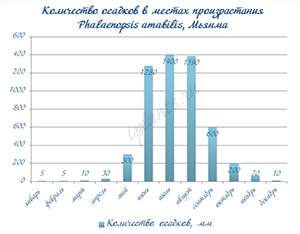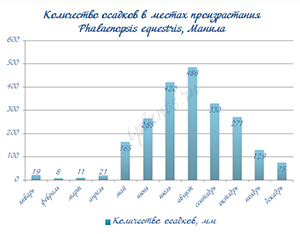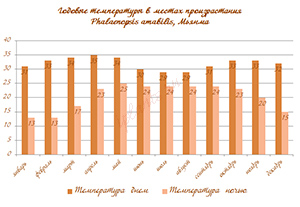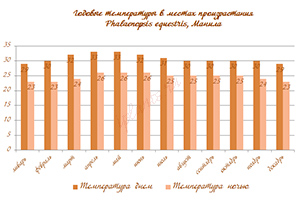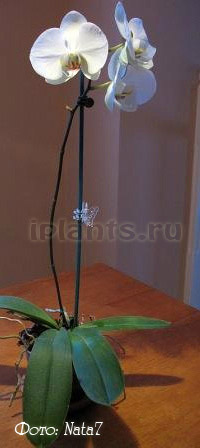
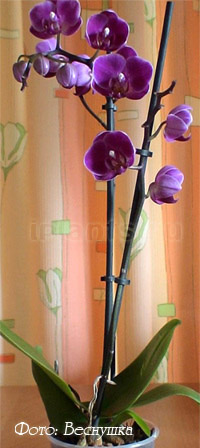
Orchid family. The homeland of phalaenopsis is South and Southeast Asia, the islands of the Malay archipelago, the Philippines, New Guinea and Northeast Australia.
In nature, these orchids grow in the tropics, in conditions of constantly high daytime temperature, air humidity and a short dry season. Phalaenopsis are monopodial epiphytic plants, with a shortened stem and a rosette of 3-5 two-row large wide, fleshy leaves. Some species have a beautiful marble pattern on their leaves.
The peduncles of phalaenopsis are long, branching, with a large number of rather large, spectacular flowers. Inflorescence is an axillary brush, it can be branched, large, multi-flowered, or simple, short, low-flowered. The phalaenopsis flowers are quite large, averaging 8-12 cm in diameter. Currently, hundreds of interspecies and intergeneric phalaenopsis hybrids have been bred. They are beautiful both as domestic plants and in cutting, especially indispensable in the bride's bouquet.
Phalaenopsis - species and varieties
In total, 77 species are described in the official list of phalaenopsis, 7 of them are not officially approved, they can also belong to clones of existing species. The most famous types of phalaenopsis:
| Phalaenopsis pleasant Phalaenopsis amabilis | Leaves are green, up to 25 cm long, shoots up to 80 cm, with 10-20 flowers. Flowers with a diameter of 10 cm, white, fragrant. It forms the largest flowers of all species and is widely used in hybridization. |
| Phalaenopsis Luddemanna Phalaenopsis lueddemanniana | Leaves are yellow-green up to 25 cm long, peduncle with 2-7 flowers. Flowers with a diameter of 5 cm, chestnut-purple with purple. |
| Phalaenopsis schilleriana | The leaves are green with a gray-green pattern, 20-25 cm long, peduncles - up to 90 cm, multi-flowered. Flowers with a diameter of 5-6 cm, light pink. |
| Phalaenopsis stuartiana | The leaves are green with a gray-green pattern, peduncles 60-80 cm long, multi-flowered. Flowers with a diameter of 5 cm, white. |
| Phalaenopsis equestrian Phalaenopsis equestris | The leaves are green, up to 15 cm long, peduncles - up to 30 cm, with 10-15 flowers. Flowers with a diameter of 2.5 cm, light pink with a purple tint. |
| Phalaenopsis olenerogii Phalaenopsis cornu-cervi | The leaves are light green, 15-25 cm long, peduncles up to 20 cm, with several flowers, flattened with protruding bracts. Flowers with a diameter of 2-3 cm, yellow-brown. |
Read more: Phalaenopsis - species and varieties.
Phalaenopsis care
Caring for an orchid phalaenopsis is the ability to create the necessary balance of temperature, humidity and substrate. At first glance, it seems simple, but in fact it turns out that orchids are very short-lived. This is because the microclimate in our house is constantly changing, it largely depends on the weather outside, not everyone manages to adapt. For plants, as a mini-ecosystem in a pot, changes even by 2-3 degrees or 3-5% of air humidity matter in the frequency of irrigation and ventilation.
Temperature and fresh air
Phalaenopsis are thermophilic, meaning they don't need a cool room in winter, and in summer you shouldn't leave it on an open balcony if it's cold at night. Comfortable temperatures for these orchids during the day are 23-28 ° C during the day, up to a maximum of 33 ° C, at night it is desirable that the temperature drops by 5-8 ° C, i.e. 18-20 ° C, at least 14 ° C. The minimum and maximum temperatures are for a short time, that is, the flower can stay 4-5 days in such conditions, but at the same time during the heat it is necessary to increase the humidity of the air, and when the thermometer drops to the lower limit of the permissible, the orchid roots should be completely dry and no spraying!
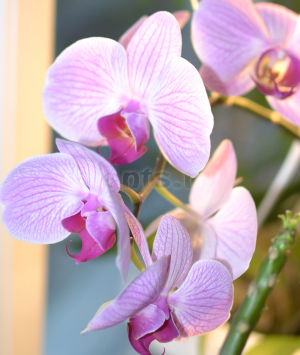

For orchids, a regular flow of fresh air is very important, that is, it is imperative to establish a ventilation regime so that at air temperatures below 20 ° C, air flows are not directed to the plant. Phalaenopsis can safely carry a small draft, but only if the air is not cold. I.e. air conditioner enemy, not friend! With increased humidity of the soil and air, phalaenopsis orchids simply need blowing - like a light breeze, in which there is no visible oscillation of the leaves. In a poorly ventilated room, pathogenic fungi and bacteria that cause phalaenopsis diseases develop very quickly. Fans solve the problem only partially, if there is no influx of fresh air, then we simply drive the air and microorganisms suspended in it around the room.
Therefore, the recipe is simple: pots with phalaenopsis should be placed so as to ensure mobility - when ventilated, it is easy to rearrange from the windowsill to the cabinet or shelf if the air temperature is below 20 ° C. Remember that hypothermia is especially dangerous with damp soil.
Phalaenopsis lighting
Phalaenopsis is photophilous, in natural conditions it grows so that it receives the sun's rays, but openwork, through the "windows" between the leaves of the trees. Burns do not occur even in heat and sunny days, because these windows constantly move after the sun. This means that at home, the east and light northwest window is ideal for phalaenopsis - if they are not shaded from the street by houses, trees. South, west, south-west direction of windows - you need shading in the hottest hours of the day from 11-30 to 16 o'clock approximately (in hotter times and southern regions up to 17 o'clock), ideally - blinds or a double layer of mosquito net. North windows for phalaenopsis, like windows of a different orientation, shaded from the street with trees or houses (especially the first floor) - not the most suitable place without artificial lighting, if you want the orchid to grow and bloom.
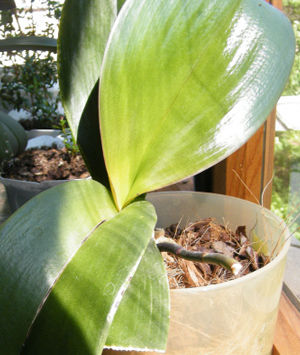

For the active growth and development of an orchid, phalaenopsis needs good lighting. Daylight hours are at least 10 hours. If there are no such conditions, then phalaenopsis will not increase the leaf mass, which means it will not bloom. And if you put the purchased flowering orchid phalaenopsis on the windowsill, it will bloom, perhaps give an increase, but the new leaves will be smaller than the previous ones, the lower leaves will gradually turn yellow and die "in old age." But all these are general concepts, the real sign of suitable lighting is the size of the sheet - the new sheet should be the same size as the old ones.
Sometimes the conditions of the house are such that the lighting is uneven - sometimes better, sometimes worse, the phalaenopsis grows in fits and starts, while there is enough light, builds up one small sheet, but then slows down again, stops growing for a long time. Periodically blooms, but with smaller flowers, or unexpectedly typing buds dries them. In such situations, phalaenopsis live 3-4 years, gradually decrease in size, as a result, they simply wither. Meanwhile, under good conditions, phalaenopsis can live at home for many years. If your windows are not bright enough, you just need to arrange additional lighting with lamps.
 If the windows are not sunny, or covered with curtains, such a lamp alone is not enough - the orchid will end flowering, the new growth will be frail. You need one 20 W lumber on both sides of the bush, a distance of 10-15 cm.
If the windows are not sunny, or covered with curtains, such a lamp alone is not enough - the orchid will end flowering, the new growth will be frail. You need one 20 W lumber on both sides of the bush, a distance of 10-15 cm.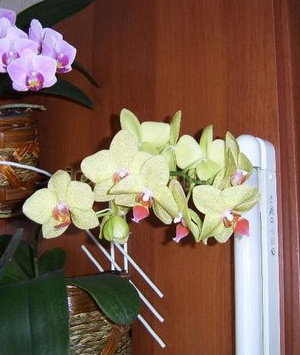 Here, additional lighting is only on one side - peduncles themselves reach for the light, but this is not enough to build up leaf mass, especially in winter.
Here, additional lighting is only on one side - peduncles themselves reach for the light, but this is not enough to build up leaf mass, especially in winter.By the way, phalaenopsis grows perfectly all year round in artificial light - use fluorescent lamps or LED (white light 4000 K). You can purchase special phytolamps, but this is not at all necessary.
How to water phalaenopsis
Phalaenopsis should be watered by immersion. This is the only acceptable method for the reason that between watering the substrate (if any) must dry completely and remain dry for several days. If you water such a substrate from a watering can, water on the dry bark and roots will simply drain into the tray, the roots will not have time to get drunk. Therefore, you need to pick up a wide jug so that the pot with the plant can be freely placed in it at the very top. We fill it with water at a temperature not lower than the ambient air, it is better to slightly heat it up to 35-37 ° C, and leave it for 10 minutes. 10 minutes is more than enough for the velamen to absorb water. If phalaenopsis has not been watered for a very long time, say two weeks, then you can leave it for 15 minutes, but not longer. Also make sure that the bases of the lower leaves do not float in the water. I.e. you only need to wet the roots in the pot and bark, and the roots at the base of the leaves, the sinuses of the lower leaves should remain dry. If you still get water, be sure to dry it - fold a piece of toilet paper with a corner and blot all the sinuses.
Important
The correctness of watering phalaenopsis entirely depends on the correct choice of pot and substrate. In nature, the roots of orchids are not limited to the walls of the pot, not covered with a layer of earth and plastic, all rainwater from the roots and leaves does not linger. Therefore, the pot should have many drain holes at the bottom (or a mesh instead of a bottom), preferably several large holes in the walls. The substrate is made of large fractions of bark (pieces about 2-4 cm in size) and a lot of free space. This is necessary so that the roots of orchids dry out very quickly. Ideally, the roots should dry out after watering in 24-36 hours. The bark itself can dry longer, but since large pieces of bark do not stick around the roots, there is no threat in this.
If the roots of the flower remain moist for longer than 1-2 days, and they remain when the pot is stuffed with finely chopped bark with an admixture of moss, then it is inevitable that the plant will rot, and then disease and death. Healthy roots are light gray with a green tip .
Reference point for proper watering :
- dry healthy roots light gray, without shade brown, rather silver
- after getting wet, they turn gray-green
- after 24-36 hours they should turn gray again
Watering frequency
It is necessary to water phalaenopsis depending on the temperature - the higher the temperature, the greater the evaporation of moisture by the leaves, i.e. when it is hot - more often, when it is colder - less often. On average, at temperatures above 22-24 ° C, about once a week. When very dry hot days in summer (in the daytime up to 30 ° C and above) - once every 3-4 days, if the temperature is below 22 ° C, about once every 7-9 days. All this provided that the orchid dries in a day! If it dries longer, do not water until everything dries 100%, no "half" - the roots should be absolutely dry for the next watering.
Watering frequency is one of the flowering controls in phalaenopsis.
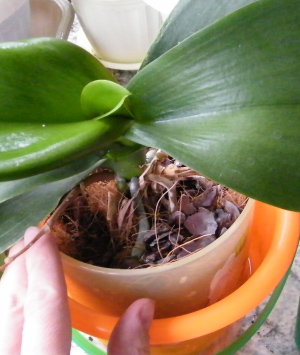 No need to immerse phalaenopsis in whole water, water should not touch the base of the leaves
No need to immerse phalaenopsis in whole water, water should not touch the base of the leaves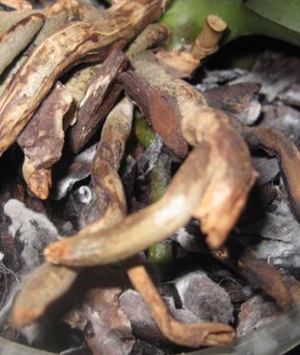 Soaking in water for 30 minutes or more leads to the formation of mold and rot.
Soaking in water for 30 minutes or more leads to the formation of mold and rot.Watering errors
It is completely unacceptable that the roots of phalaenopsis together with the bark dry in a pot for 5-7 days, so the frequency of watering (the rate of drying of the soil) depends on the weather - the ambient temperature and humidity. As soon as the humidity rises when the weather changes (rains, cloudy, especially when the heating has already been turned off or has not yet been turned on), carefully monitor the condition of the bark. If you notice it's been three days now, it's still raw and the roots are still green rather than light, don't expect rot - put the pot on its side and shake out some of the bark. While it is not yet necessary to shake out the entire contents of the pot, even after polishing it, you will speed up the drying, and everything can do.
What water to water
Water for watering phalaenopsis is needed exclusively soft, if there is hard water in your area, then special filters are needed to eliminate excess salts. Conventional filters purify water of mechanical impurities, excess chlorine, heavy metals and everything. In nature, orchids are drunk with rainwater with nutrients dissolved in it from the bark of the trees on which they grow. In our tap water, there is nothing harmful to orchids: chlorine, fluoride, iron.
By the way, it is generally very difficult to get rid of excess fluoride, reverse osmosis filters are needed here. The need for them arises when it is reliably known that in your quarter the fluoride content in the water is exceeded. These indicators differ greatly not only in areas and districts, but also within the same city. Meanwhile, fluoride in irrigation water is toxic to phalaenopsis, inhibits growth, and causes the development of leaf necrosis. Increased fluoride content in water is observed in industrial areas, especially where aluminum production, fertilizer plants, etc. And fluoride standards in water should not exceed 0.05 mg/l.
Thus, orchids should be watered with at least filtered and boiled water, if a very good filter is filtered, but not tap water. There is an option to water with distilled water, if at the same time the orchid grows exclusively in the bark (without foam plastic, cork), then while the fresh bark can be dispensed with without top dressing, but gradually the nutrients from the bark are washed out (in three months), and fertilizers will have to be added to distilled water with each watering, but reduce its dosage by about 3-4 times from the recommended one .
But it is even better to visit a shop for aquarists and purchase funds to prepare water for the aquarium. Specialists breeding tropical fish have long used a wide range of drugs that allow measuring the pH of water and changing it in one direction or another: pH + and pH -. There are means that make tap water suitable for fish, and in our case orchids, almost immediately.
Fertilizing
The crucial point is feeding phalaenopsis, here the difference from other indoor plants is that feeding does not depend on the time of year, but depends on the physiological state of the plant.
 Schultz orchids NPK 19% -31% -17%, 1/2 teaspoon per 3 liters of water.
Schultz orchids NPK 19% -31% -17%, 1/2 teaspoon per 3 liters of water.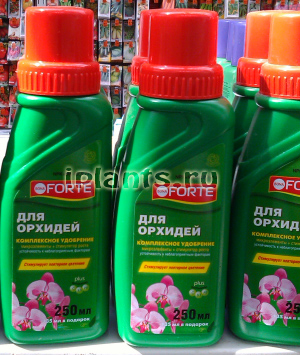 4: 2.5: 6 Bona Forte for NPK orchids, dilute 5 mL to 1.5 L of water.
4: 2.5: 6 Bona Forte for NPK orchids, dilute 5 mL to 1.5 L of water.Let's immediately indicate the moments when you can feed phalaenopsis and when you cannot:
| can be fed | can not be fed |
|---|---|
| plants in leaf growth phase | plants showing no signs of growth |
| orchids that do not have rot and other diseases | orchids with root decay, fungal and bacterial infections |
| peduncle begins to grow, buds form | from the moment the buds bloom until the end of flowering |
| weekly orchids grown without substrate or completely on an inert substrate (cork, foam, etc.) | orchids planted in fresh bark, first month after transplant |
| when watered with distilled water | when watering with aquarium water, the appearance of a salt deposit on the walls of the pot and bark |
If you bought a phalaenopsis orchid in bloom, do not rush to feed it, even forbid yourself to do it - only watering, just water. Starting to feed, you can stimulate the plant to grow - it will dry out the flowers and continue to grow leaves.
Air humidity
It is believed that phalaenopsis require a high humidity of about 60-80%, partly this is true - a comfortable humidity for them is just 60%. But even at 50% they feel good without spraying. When spraying is needed - when the air humidity drops below 40%. Above - completely unnecessary, even superfluous, and can even harm if drops from water fall into the axils of the leaves or spraying interferes with the rapid drying of the soil after irrigation. But humidity above 60% can be risky, as already mentioned due to the duration of drying the substrate and due to the likelihood of the development of pathogenic microorganisms. Phalaenopsis is very susceptible to rot and bacteriosis, so with humidity above 60%, very good ventilation is needed! Do not forget that in natural conditions, the average humidity is 70-75%, but round-the-clock ventilation is wind.
Therefore, if the air is very dry, for example, in winter in severe frosts, hair from the comb takes off, curtains sparkle, humidity is about 20% - phalaenopsis orchids can be sprayed from a small spray bottle, but it is better to put an air humidifier next to it, or cover the batteries with wet sheets as soon as they dry, wet again.
Substrate for Phalaenopsis
There are three options for growing phalaenopsis:
-
in bark
- substrate in a
- mixture of bark and inert components (wine cork, foam pieces, shell) in
- a non-strata version (on a block, in an empty basket)
Important: a fraction of bark and other components of such a size that there is a lot of empty space inside the pot, large air pockets. So that after watering the roots dry out quickly enough for 1-1.5 days. The bark itself can dry longer, especially large pieces, but it should not wrap around the roots with a continuous moist rotten layer. I.e. pieces 0.5-1 cm - too small. It is desirable to have pieces of bark about 3 cm. And inert additives that do not absorb water can be much larger - 4-5 cm.
 You can buy ready-made bark (sterilize by cooking, then dry).
You can buy ready-made bark (sterilize by cooking, then dry).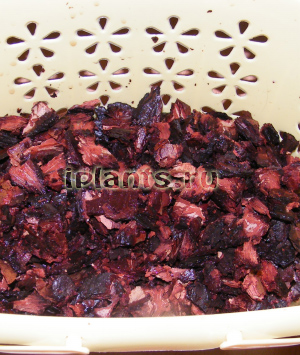 You can prepare your bark, take away only large pieces of 3-4 cm, throw out the dust.
You can prepare your bark, take away only large pieces of 3-4 cm, throw out the dust.Important: do not use store soil for orchids! Most of these soils have the following composition as soil from Aurika Gardens: peat, sphagnum, bark, pine needles, charcoal, double superphosphate, potassium sulfate, micro-fertilizers - all fractions are very small, some are just dust, and moss is too moisture-intensive for phalaenopsis. This manufacturer has another option specifically for phalaenopsis: pine bark, sphagnum, coconut chips, charcoal, coconut fiber - the same powder dust and pieces of moss in it. The third option from "Garden of Miracles," even worse: long-fiber screening of a large fraction of top peat, limestone flour, minerals - no comment!
It is much easier: buy only bark, or cook it yourself - prepare in the forest, cut into pieces and boil in a basin, changing water several times to get rid of tar and pests.
There are ideas for using nut shells and seed husks as an inert additive, but rukodelie.net/plants does not recommend: first, the fine fraction is few voids; secondly, the shape of the shell is concave, and in some places water will remain in them, because of such "puddles" the bark and roots will dry longer. Foam or pieces of cork are a proven material, but take pieces of foam only from old packages that have been lying for about six months or more. This is very important as fresh foam releases volatile toxic compounds. And, despite the fact that phalaenopsis is an excellent phytofilter plant, i.e. absorbs and decomposes harmful substances from the air (benzene, toluene and formaldehyde), such a load does not benefit the plant .
Phalaenopsis orchid transplant
You need to know about phalaenopsis that it does not tolerate transplantation and any root injuries. Therefore, it is transplanted not annually, but as necessary, in the following cases:
- if the plant was heavily flooded and eating rotten roots
- the soil deteriorated, rotted, rusted, crumbled strongly and turned into dust
- pot smells bad
- shell mites crawl out of the pot
- root pests appeared
- the pot became so cramped and small that the roots made a nest and pushed the plant out of the pot
- the pot is unstable, constantly falling
 Mistakes: you need to fix the plant not with sharp wire, but soft in the braid, and put a piece of foam, cork, coconut fiber under the "ass" of phalaenopsis, but not bark!
Mistakes: you need to fix the plant not with sharp wire, but soft in the braid, and put a piece of foam, cork, coconut fiber under the "ass" of phalaenopsis, but not bark!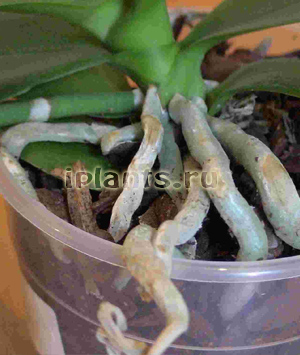 If the roots crawl out of the pot to the sides - this is not a reason to replant the orchid, the main thing is that the pot remains stable and the orchid does not shake in it!
If the roots crawl out of the pot to the sides - this is not a reason to replant the orchid, the main thing is that the pot remains stable and the orchid does not shake in it!The roots of phalaenopsis have a particularly tender place - the very tip of the root, the one that is green. In a growing root, it is not protected by velamen, the slightest scratch, and an infection gets through the wound, or the root immediately stops growing (pupates), the plant spends energy on growing new roots. Therefore, any manipulations for transplantation and rearrangement are extremely careful. If necessary, break the pot (plastic can be cut at the sides with a sharp knife). If you transplant from a clay pot so that the roots are separated from its walls, you will have to water. If there is no sticking, it is better to transplant phalaenopsis with dry roots and after transplantation do not water for 2-3 days. When planting, do not bury the base of the lower leaves .
For pot stability:
- If it seems to you that the plant is sitting unsteadily, fix the support inside it, to which attach the orchid (with capron ropes).
- If it seems to you that the pot is light and can fall, when transplanting to the bottom, put 2-3 ordinary stones so that they do not clog the drainage holes.
What to plant phalaenopsis
-
into
- a plastic or clay pot that has many drainage holes into
- a woven wooden or plastic basket into
- a wide flowerpot without holes and without soil, fix with wire
- attach to block
 Ties, scissors, sink net. The filler is not bark, but coconut fiber. To extract an orchid from such a basket, you just need to cut it.
Ties, scissors, sink net. The filler is not bark, but coconut fiber. To extract an orchid from such a basket, you just need to cut it. such a basket, during watering, it is important that the protruding roots are not injured on the walls of the jug - bathe only in spacious dishes.
such a basket, during watering, it is important that the protruding roots are not injured on the walls of the jug - bathe only in spacious dishes.If you choose a pot for phalaenopsis, then the holes should be slightly smaller than pieces of bark or cork. The wicker basket is good, but sometimes the roots sprout through it, and if it becomes necessary, say, processing from pests or rot, there will be difficulty with extraction, it is a pity to cut a beautiful basket. But if you immerse with it in a solution of a fungicide or insecticide, it will be saturated with the solution, and then it will evaporate the remnants of chemistry for a long time .
Sometimes they use a version of a basket lined with cellophane from the inside, but we need the orchid roots to breathe! And what breath is in the bag? In such a basket lined with film, it is advisable to keep an orchid without a substrate or use a small piece of coconut fiber instead of bark - a good material for orchids (allows the roots to breathe, does not injure), does not rot! But it is inert (does not give any nutrition) and does not fix.
How to grow phalaenopsis without substrate
Very simple - no roots, cork, foam and anything. All you need is a soft, flexible material to anchor the orchid, such as nylon thread. We take capron tights and trim them with strips - a great material for attaching orchids. Inside the pot or flowerpot in the center, you need to install a vertical support (screw on a self-tapping screw, glue), you can wrap it with coconut fiber and attach an orchid to it. This is only necessary so that phalaenopsis does not fall out of the pot during transfer, watering and is not injured.
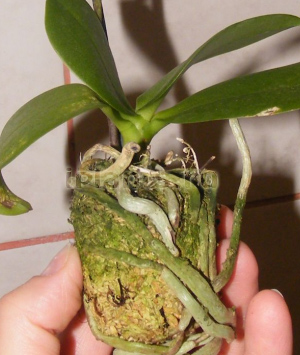 From the store: tick, moss, rot. Soak, treat from tick, dry.
From the store: tick, moss, rot. Soak, treat from tick, dry.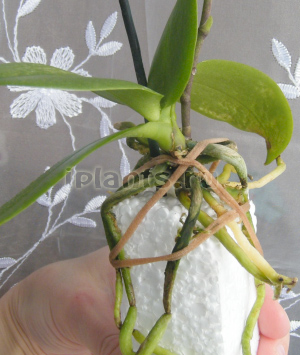 Attach with a capron stocking, fix a piece of foam in the neck of a glass jar.
Attach with a capron stocking, fix a piece of foam in the neck of a glass jar.When growing phalaenopsis without a substrate, nutrients must be added to the water with each watering. You can breed fertilizer by carefully reading the instructions - all manufacturers have different doses, you need to take less than 3-4 times. But the fertilizer must be complex and, in addition to nitrogen, phosphorus and potassium, contain all the necessary trace elements. If there is no such fertilizer, then prepare a watering solution by infusing it on pine bark. We take the pine bark and fill it with hot water (about 45 ° C), after 20 minutes we pour it into a jug through a sieve, it will just cool to the desired temperature. The option of growing an orchid without a substrate is very convenient - you can easily control the frequency of watering, the roots dry out quickly and efficiently!
Phalaenopsis blooms
The phalaenopsis orchid is able to bloom for a very long time - about three months (sometimes longer) at any time of the year with proper care and if the conditions for flowering favor the growth of dormant flower buds. And what are these conditions? You may be surprised, but this question cannot be answered unequivocally. That's why: all the phalaenopsis that we buy in the store - hybrids obtained from breeding, crossing between species, and their genetic set can be very different. Meanwhile, the original species that are used to breed domestic phalaenopsis grow in different conditions. Yes, they are all epiphytes, all grow on trees (or lithophytes - in crevices of rocks), but all at different heights above sea level, have a different degree of expression of seasonality: fluctuations in temperature and precipitation.
Let's compare the two species widely used in breeding, according to the conditions of their habitat in nature. Phalaenopsis pleasant Phalaenopsis amabilis (climate in the South of Java) and Phalaenopsis rider Phalaenopsis equestris (climate Manila, Philippines). For us, everything seems to be the same - both grow somewhere in the south, where it is warm, on the ocean, but take a closer look:
The difference is significant, and it inevitably affects the requirements of hybrids for flowering and growth conditions. Phalaenopsis pleasant hybrids are more cold-resistant, they need serious temperature fluctuations, the change of the dry and wet period is more pronounced than that of Phalaenopsias rider hybrids. The colder the nights, the less precipitation during this period, respectively, at home - less often watering.
To stimulate flowering, we need to mimic seasonality by increasing the intervals between watering. Moreover, the increase is quite significant, but some hybrids need really tough conditions, others - softer. At first, try watering about half as often - not once a week, but once every two weeks, but if the humidity is below 40%, put a tray of water next to it. No need to spray, as the orchid will evaluate large drops of water as watering.
In addition, you need to stop all top dressing - this is a prerequisite.
It is more difficult to create temperature fluctuations, but usually a decrease of 5 ° C per month is enough, hybrids are not as demanding on temperatures to stimulate flowering as on the seasonality of watering. Unfortunately, when buying hybrid phalaenopsis from a store, we can rarely figure out the parents and determine which original species is closer. Therefore, for some owners, phalaenopsis blooms often and quite willingly, it is enough to water less often for a month, while for others, orchids need to be hard whipped, transferred to the regime of growing succulents for about 2-3 months. General recommendations - after the appearance of a peduncle, the optimal average air temperature is 19-22 ° С.
As for the influence of illumination on the flowering of phalaenopsis: in nature, orchids never lack it, at home - a piece of the window sees the sun less and less from August, sometimes there is a damp and cloudy July... Very good lighting is required for flower arrow growth and bud formation. Depending on your region - in the south from November, in the north from September, you will need additional illumination. The light from the chandelier that you turn on in the evening after work is not enough - the phalaenopsis needs its own lamp, not heating, which can be placed at a distance of 10-15 cm.
How to make phalaenopsis bloom
It was previously believed that the flowering of phalaenopsis stimulates temperature fluctuations - with a decrease in temperature at night by about 5-6 ° C for two to four weeks in a row (usually in autumn), despite the fact that during the day the temperature could be 28-29 ° C.
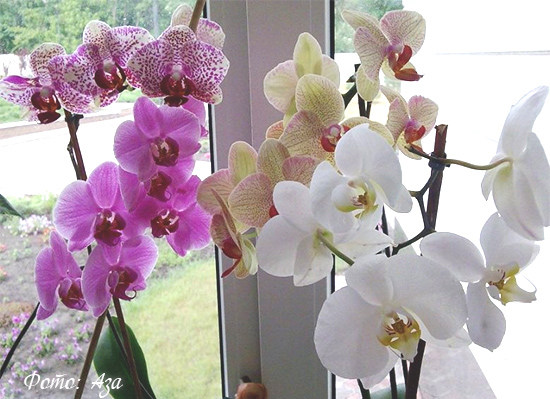
In 2006, Matthew G. Blanchard and Erik S. Runkle found that stimulation of phalaenopsis blooms is a decrease in daytime temperature below 27 ° C, and temperature at night does not have any effect.
Blanchard and Runkle grew clones of the same phalaenopsis for 20 weeks, at different temperatures but with the same humidity and light. As a result of experiments, it turned out that flowering was more abundant at day/night at 20/14 ° C or 23/17 ° C and at average daily temperatures from 14 ° C to 17 ° C.
Those orchids that were grown continuously at day/night conditions of 29/17 ° C or 29/23 ° C did not bloom. (Journal of Experimental Botany Volume 57, Issue 15, Matthew G. Blanchard and Erik S. Runkle, 2006). Thus, if your phalaenopsis does not bloom, it is worth considering how you can regulate the temperature and, accordingly, watering (as mentioned above).
Phalaenopsis reproduction
Phalaenopsis is propagated in industrial greenhouses by seeds, and at home by children, which can form on a peduncle. Sometimes daughter sockets are formed themselves without any witchcraft, and sometimes they do not want to be childish. There is a way to stimulate the formation of children with the help of cytokinin paste, it contains plant hormones. The question is whether this is how you need to cause phalaenopsis to detonate.
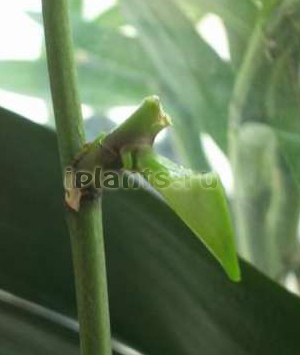 The phalaenopsis baby was formed on the peduncle using hormonal paste.
The phalaenopsis baby was formed on the peduncle using hormonal paste.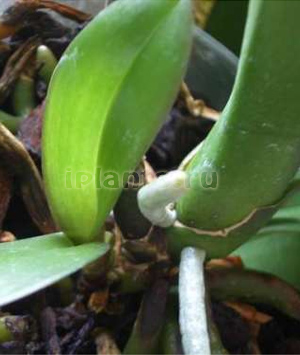 The baby was formed from a kidney at the base of the bush (itself).
The baby was formed from a kidney at the base of the bush (itself).Regarding the artificial stimulation of the development of daughter rosettes on orchids, all flower growers are divided into two camps - some believe that there is no harm from stimulation, others - that it is not worth going against nature if the orchid does not detonate itself, which means that the mother plant is not yet ready for such a feat, moreover, growing a baby can exhaust mom.
In fact, the arguments of opponents of artificial stimulation of orchids are serious and often confirmed in practice - in some cases, the mother plant ages prematurely, there is degeneration, grinding of the bush. Therefore, the general recommendations of rukodelie.net/plants are as follows: you can try to apply hormonal paste only on a healthy plant, not on the one bought by those blooming in the store! The flowers on the store orchid are not a sign of health - while it lived on the shelf, in a transparent packaging bag and poured from a hose with dubious water, the roots began to rot. 90% of purchased orchids turn out to have rotten roots. Another thing is if the orchid has been growing for you for a long time and the bloom is your own and full. The irrigation regime has long been established and there are no health problems. Never stimulate more than 2 buds per orchid.
How to spread cytokinin paste
On the phalaenopsis peduncle you can see nodules covered with very small dry covering scales, the enclosing knot very tightly. If you just put together a leaf flake, you can too injure the kidney under it, so you need to lift it in jewelry. To do this, use a sterilized needle, wipe the knot itself with a cotton pad moistened with miramistin.
Then apply the hormone paste, smearing about 2mm. The paste should get under the scales on the exposed kidney. Whether your experience turned out or not, you will see in a week - a sprout will appear from the kidney (or not). And a small outlet from it will grow in 6-8 weeks.
How to care for a phalaenopsis baby
When the baby begins to grow, it continues to feed on the mother plant, but when the roots grow more than 1.5 cm, the baby requires its care. And it consists in swimming in the same mode as the maternal one. There is no need to constantly spray the baby - moisture settling between the leaves can cause decay. She should also swim - not for long at first, two minutes - just substitute a bowl of boiled water for her. But do not immerse the baby herself in water - only roots. If it grows in such a way that it is impossible to substitute a cup of water for it, it is better not to bathe at all.
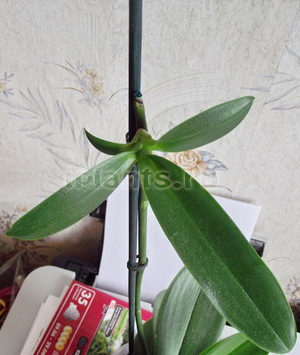 The baby has grown big, but there are no roots yet, you can tie a piece of moss-sphagnum lower in the peduncle so that it does not touch the leaves. It is slightly (!) So that it does not flow in streams to moisten.
The baby has grown big, but there are no roots yet, you can tie a piece of moss-sphagnum lower in the peduncle so that it does not touch the leaves. It is slightly (!) So that it does not flow in streams to moisten.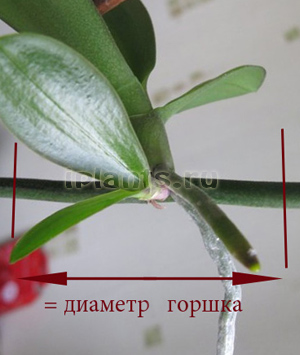 The baby has formed good roots, you can separate, but very carefully with a sharp knife.
The baby has formed good roots, you can separate, but very carefully with a sharp knife.If the humidity is very low (20-30%) in dry hot weather, put the pot on a wide tray with wet pebbles to prevent water from flowing into the pot, turn on the humidifier.
When the children of phalaenopsis grow large, have roots about 5-7 cm, they can be separated: make a cut about 2 cm lower on the peduncle. Dust both cuts with sulfur powder, ground cinnamon or crushed birch charcoal. The cut baby should simply be placed on the surface of the bark in a prepared pot, it is better to fix it to the support. The roots themselves will find a way where they grow.
Phalaenopsis diseases
Phalaenopsis, as well as any plants, can be affected by fungal, bacterial and viral infections. In terms of the frequency of problems with orchids, root decay always comes first.
The traditional reason is too frequent or abundant watering, i.e. too long dries the soil, or too long soaking during watering by immersion. It is possible to treat rotten phalaenopsis, but the probability of its recovery is about 50%. The fact is that microorganisms that develop when roots rot release toxins that spread throughout the plant and cause its slow death.
There are many causative agents of infections, but everything comes down to one thing - the roots of phalaenopsis become dirty brown, the leaves turn yellow, wilt, wrinkle, as if the plant suffered from overdraft. But inside the pot is usually raw bark, often blue-green algae.
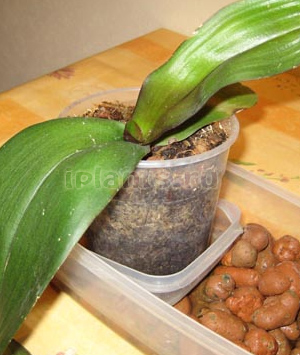 What leads to the disease: moss, no holes, air to the roots, water around, frequent feeding.
What leads to the disease: moss, no holes, air to the roots, water around, frequent feeding.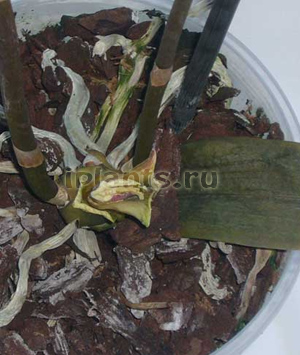 So ends...
So ends...You can prevent the rot of the roots of phalaenopsis:
- provide good aeration - a lot of voids in the pot, holes on the sides of the pot and at the bottom, good ventilation in the apartment
- exclude components from the soil composition that can rot quickly (leaf litter) and retain moisture for a long time (sphagnum moss, peat and bark in pieces less than 2 cm)
- do not use fertilizers for other indoor plants and organic matter
- no growth stimulants
- prevent hypothermia
- prevent roots from remaining raw for longer than 1.5 days
Treatment of phalaenopsis rot
Cutting out rotten places, sprinkling sections with disinfectants, but not green, but ground cinnamon or sulfur. Now you need to prepare a new fresh substrate, sterilize it and dry it. Do not water or spray the transplanted orchid for at least 5 days. If it is very hot, above 28 ° C, you can pour on the third day, but not by immersion, but slightly from the watering can, drain all the water from the tray.
There are also drugs for the treatment of rot - fundazol (benomil) and maxim. But, unfortunately, the drug maxim is ineffective, and fundazole is very toxic to humans and can be toxic to the plant (the constituent components decompose, forming toxic compounds). Therefore, the chances of coping with the help of chemistry, in fact, are not as great as you hope. And in half of the cases, even after treatment with fungicides, the plant dies.
Phalaenopsis pests
Insects are the same as on other flowers - thrips, shields, mealybugs, less often whiteflies. Signs and treatment typical - insecticides, preferably actara or confidor, bred according to the instructions.
 Spider mite on phalaenopsis - depressed light spots, the tip of the leaf turns yellow.
Spider mite on phalaenopsis - depressed light spots, the tip of the leaf turns yellow.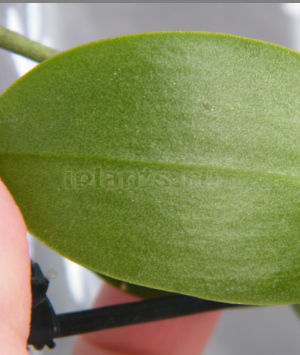 The same sheet on the back - you see the smallest white dots - tick skins.
The same sheet on the back - you see the smallest white dots - tick skins.But if arthropods are harmful, everything is more complicated. The most dangerous enemies are a wide and cyclamen tick, to a lesser extent - a spider web. The first ones are so small that they are completely invisible even with a magnifying glass. Spider webs are larger, visible to the naked eye. Any ticks can only be treated with acaricides, alternating drugs with different active substances. But most importantly, it is necessary to treat all plants on the windowsill and thoroughly wash the windowsill, glass and even wash the curtains.
